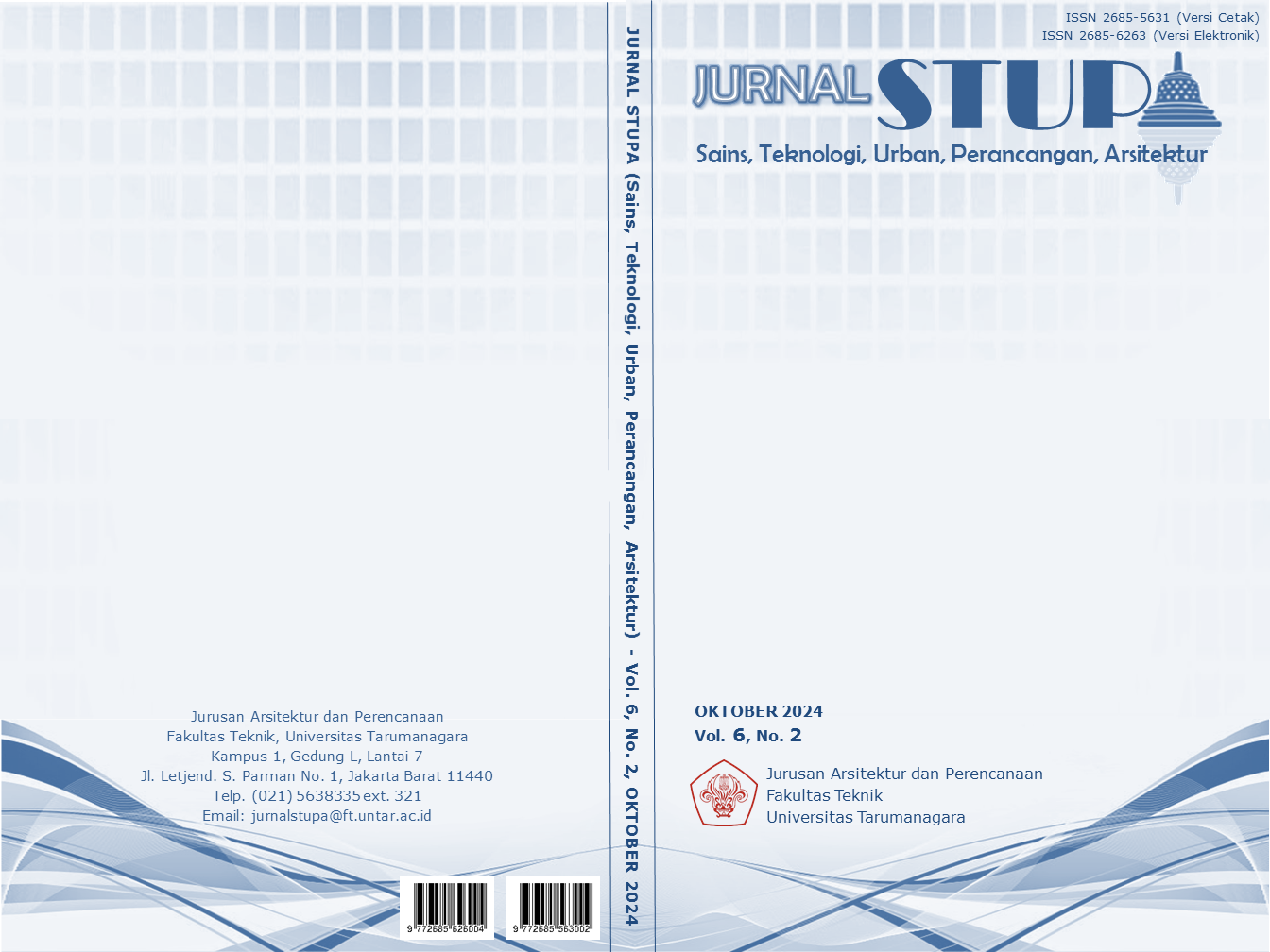IMPLEMENTASI EVERYDAYNESS DAN TRANSPROGRAMMING PADA PUSAT PERBELANJAAN MELAWAI PLAZA
Main Article Content
Abstract
The Blok M area was previously known as a favorite "hang out" place for young people in the 80s and 90s. This is demonstrated by the existence of 'Lintas Melawai' as an exhibition for private vehicles together with popular Indonesian works inspired by the area. The popularity of Blok M was also influenced by the development of business and shopping centers which at that time were the only area that had 3 shopping centers at once in Jakarta, namely Plaza Aldiron, Plaza Melawai, and Plaza Blok M. Melawai Plaza, which was founded in 1983, was crowded with visitors at the same time. with the popularity of 'Lintas Melawai'. Entering the 2000s, shopping centers in the Blok M area began to quiet down due to the emergence of interest in more modern shopping centers in the south of Jakarta. This condition also had an impact on Melawai Plaza, plus the impact of the Covid-19 pandemic in 2019-2021 which caused most shops to go bankrupt and were forced to close. Currently Melawai Plaza is a placeless building with its "hanging out" identity lost and its design less flexible to current developments. Therefore, it is hoped that the research can reconnect lost historical identities, repair the disconnect between users and Melawai Plaza, and adapt to regional and contemporary developments. Through an everydayness approach to collecting existing building data and transprogramming to process the data into different program configurations, program proposals were obtained, namely Retail and Interactive ExhibiGold, Communal Space, and Skate Park. It is hoped that the resulting design proposal will wrap Melawai Plaza in a new identity and give the meaning of place to Melawai Plaza.
Keywords: everydayness; Melawai Plaza; placeless place; transprogramming
Abstrak
Kawasan Blok M dahulu dikenal sebagai tempat “nongkrong” favorit bagi kawula muda di era 80 hingga 90an. Hal ini ditunjukkan dengan adanya ‘Lintas Melawai’ sebagai ajang pameran kendaraan pribadi bersama karya-karya populer tanah air yang terinspirasi dari kawasan tersebut. Popularitas Blok M juga dipengaruhi oleh perkembangan pusat bisnis dan perbelanjaan yang kala itu menjadi satu-satunya kawasan yang memiliki 3 pusat perbelanjaan sekaligus di Jakarta, yaitu Plaza Aldiron, Plaza Melawai, dan Plaza Blok M. Melawai Plaza yang berdiri sejak tahun 1983 ramai dikunjungi bersamaan dengan popularitas ‘Lintas Melawai’. Memasuki tahun 2000an, pusat perbelanjaan di kawasan Blok M mulai sepi karena munculnya peminat pusat-pusat perbelanjaan di selatan Jakarta yang lebih modern. Kondisi ini juga berimbas pada Melawai Plaza, ditambah adanya dampak pandemi Covid-19 pada tahun 2019-2021 yang menyebabkan sebagian besar toko bangkrut dan terpaksa tutup. Saat ini Melawai Plaza menjadi bangunan placeless dengan identitas “nongkrong”-nya yang hilang dan desainnya yang kurang fleksibel terhadap perkembangan zaman. Oleh karena itu, penelitian diharapkan dapat menghubungkan kembali identitas historis yang hilang, memperbaiki diskoneksi antara pengguna dan Melawai Plaza, serta menyesuaikan perkembangan kawasan dan zaman. Melalui pendekatan everydayness untuk pengumpulan data bangunan eksisting dan transprogramming untuk mengolah data menjadi konfigurasi program yang berbeda, didapatkan usulan program, yaitu Retail and Interactive ExhibiGold, Communal Space, serta Skate Park. Usulan perancangan yang dihasilkan, diharapkan akan membungkus Melawai Plaza dalam identitas baru serta memberi makna place pada Melawai Plaza.
Article Details

This work is licensed under a Creative Commons Attribution-NonCommercial-ShareAlike 4.0 International License.
This work is licensed under a Jurnal Sains, Teknologi, Urban, Perancangan, Arsitektur/ STUPA Creative Commons Attribution-NonCommercial-ShareAlike 4.0 International LicenseReferences
Baswedan, A., dan Sabandar, W. P.. Menuju Ratangga, Kereta Kota Kita.
Bennett, C., & Hanks, L. (2023). Place through Time: Investigating Place Identity Language within the Temporal Dimension. DEPARCH Journal of Design Planning and Aesthetics Research, 2(2), 115-140.
Cresswell, T. (2004). Place: a short introduction.
Cupers, K. (Ed.). (2013). Use matters: an alternative history of architecture (p. 288). London: Routledge.
Gehl, J., dan Svarre, B. (2013). How to study public life. Island Press.
Lefebvre, H., & Levich, C. (1987). The everyday and everydayness. Yale French Studies, (73), 7-11.
Lynch, K. (1964). The image of the city. MIT press.
Miller, D. (1998). Shopping, place, and identity. Psychology Press.
Rapoport, A. (1990). The meaning of the built environment: A nonverbal communication approach. University of Arizona Press.
Relph, E. (1976). Place and Placelessness. London: Pion.
Tschumi, B. (2005). Event-Cities 3. The MIT Press.
Tuan, Y. F. (1977). Space and place: The perspective of experience. U of Minnesota Press.
Whyte, W. H. (1980). The Social Life of Small Urban Spaces.
Xie, S. (2023). Rethinking the everydayness of Dutch 20th-Century malls.
Yetti, E., & Mujiningsih, E. N. (2021). MELACAK JAKARTA DARI 1950-AN SAMPAI DENGAN 1970-AN DALAM KARYA SASTRA. LOA: Jurnal Ketatabahasaan dan Kesusastraan, 16(1), 1-14.
Yulian, E. Y., Fransiska, W., & Ardiansyah, A. (2017). Perencanaan Dan Perancangan Shopping Mall Di Kota Palembang. Skripsi. Universitas Sriwijaya. Palembang.



